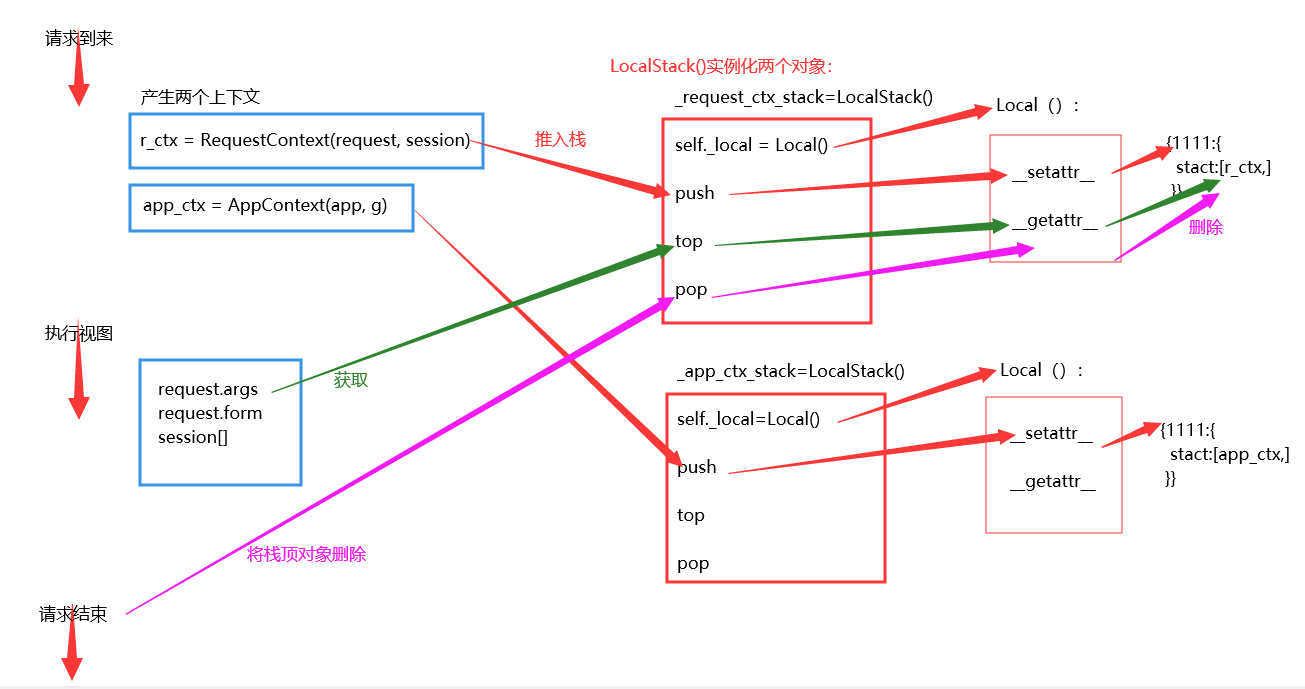LocalStack 和 Local 实现上下文管理
面向对象
class Foo(object):
def __setattr__(self, key, value):
print(key,value)
def __getattr__(self, item):
print(item)
obj = Foo()
obj.x = 123 # 执行setattr
obj.x # 执行getattr
列表实现栈
后进先出,通过列表可以实现一个栈。
v = [11,22,33]
v.append(44)
v.pop()
问题:
flask为什么需要栈结构?
需要栈结构,能够将两个上下文推到栈中去。
LocalStack 和 Local 解析源码 local.py
try:
# 获取线程(协程)ID
from greenlet import getcurrent as get_ident
except ImportError:
try:
from thread import get_ident
except ImportError:
from _thread import get_ident
"""
产生一个字典
__storage__ = {
1111:{"stack":[汪洋] }
}
"""
class Local(object):
def __init__(self):
# self.__storage__ = {}
# self.__ident_func__ = get_ident
object.__setattr__(self, "__storage__", {})
object.__setattr__(self, "__ident_func__", get_ident)
def __iter__(self):
return iter(self.__storage__.items())
def __release_local__(self):
self.__storage__.pop(self.__ident_func__(), None)
def __getattr__(self, name):
try:
return self.__storage__[self.__ident_func__()][name]
except KeyError:
raise AttributeError(name)
def __setattr__(self, name, value):
ident = self.__ident_func__() # 1111
storage = self.__storage__
try:
storage[ident][name] = value
except KeyError:
storage[ident] = {name: value}
def __delattr__(self, name):
try:
del self.__storage__[self.__ident_func__()][name]
except KeyError:
raise AttributeError(name)
class LocalStack(object):
def __init__(self):
self._local = Local()
def push(self, obj):
"""Pushes a new item to the stack"""
# self._local.stack == getattr
# rv = None
rv = getattr(self._local, "stack", None)
if rv is None:
self._local.stack = rv = []
rv.append(obj)
return rv
def pop(self):
stack = getattr(self._local, "stack", None)
if stack is None:
return None
elif len(stack) == 1:
# release_local(self._local)
# del __storage__[1111]
return stack[-1]
else:
return stack.pop()
@property
def top(self):
try:
return self._local.stack[-1]
except (AttributeError, IndexError):
return None
obj = LocalStack()
obj.push('汪洋')
obj.push('成说')
print(obj.top)
obj.pop()
解释:
local类,和threading.local的功能一样,为每个线程开辟空间进行存取数据,Local内部维护一个字典,以线程(协程)ID为key,进行线程之间数据隔离,如:
__storage__ = {
1211:{'k1':123},
1222:{'k2':123}
}
obj = Local()
obj.k1 = 123
LocalStack的类,它内部会依赖local对象,local对象负责存储数据,localstack对象用于将local中的值维护成一个栈(用push、top、pop方法)。
__storage__ = {
1211:{'stack':['k1',]}
}
obj= LocalStack()
obj.push('k1')
obj.top
obj.pop()
LocalStack类两个实例对象
_request_ctx_stack = LocalStack()
_app_ctx_stack = LocalStack()
也就是说这两个对象都能够各自维护各自的字典(能使用push、top、pop方法属性),其中_request_ctx_stack对象会将请求对象RequestContext(reqeust,session)推入到自己的栈中;
而_app_ctx_stack对象会将flask核心对象AppContenxt(app,g),推入到自己的栈中。
RequestContext(reqeust,session) :请求上下文
AppContenxt(app,g):应用上下文
# context locals
__storage__ = {
1111:{'stack':[RequestContext(reqeust,session),]},
1123:{'stack':[RequestContext(reqeust,session),]},
}
_request_ctx_stack = LocalStack()
__storage__ = {
1111:{'stack':[AppContenxt(app,g),]}
1123:{'stack':[AppContenxt(app,g),]},
}
_app_ctx_stack = LocalStack()
流程图:

总结:
1. 当请求到来时,首先会创建出两个上下文对象,RequestContext(reqeust,session)封装了request和session、AppContenxt(app,g)封装了app和g;
LocalStack()实例化两个对象`_request_ctx_stack `、`_app_ctx_stack`;并且在`__init__`初始化时,通过` self._local = Local()` 创建一个_local对象,而Local类会创建一个__storage__大字典,并且会以线程ID作为Key。
```
# 字典结构:
__storage__ = {
1111:{},}
```
LocalStack()类的两个实例化对象会执行 `push`方法,`_request_ctx_stack`将` RequestContext(reqeust,session)`对象推入自己的栈中,而`_app_ctx_stack`将`AppContenxt(app,g)`对象推入自己的栈中;
```
# 字典结构:
__storage__ = {
1111:{'stack':[RequestContext(reqeust,session),]},}
__storage__ = {
1111:{'stack':[AppContenxt(app,g),]},}
```
2. 当执行视图函数时,request.form/args、 session等,这时候会执行 `top`方法,去获取RequestContext对象;
3. 当请求结束时,执行`pop`方法将AppContext和RequestContext弹出去。



